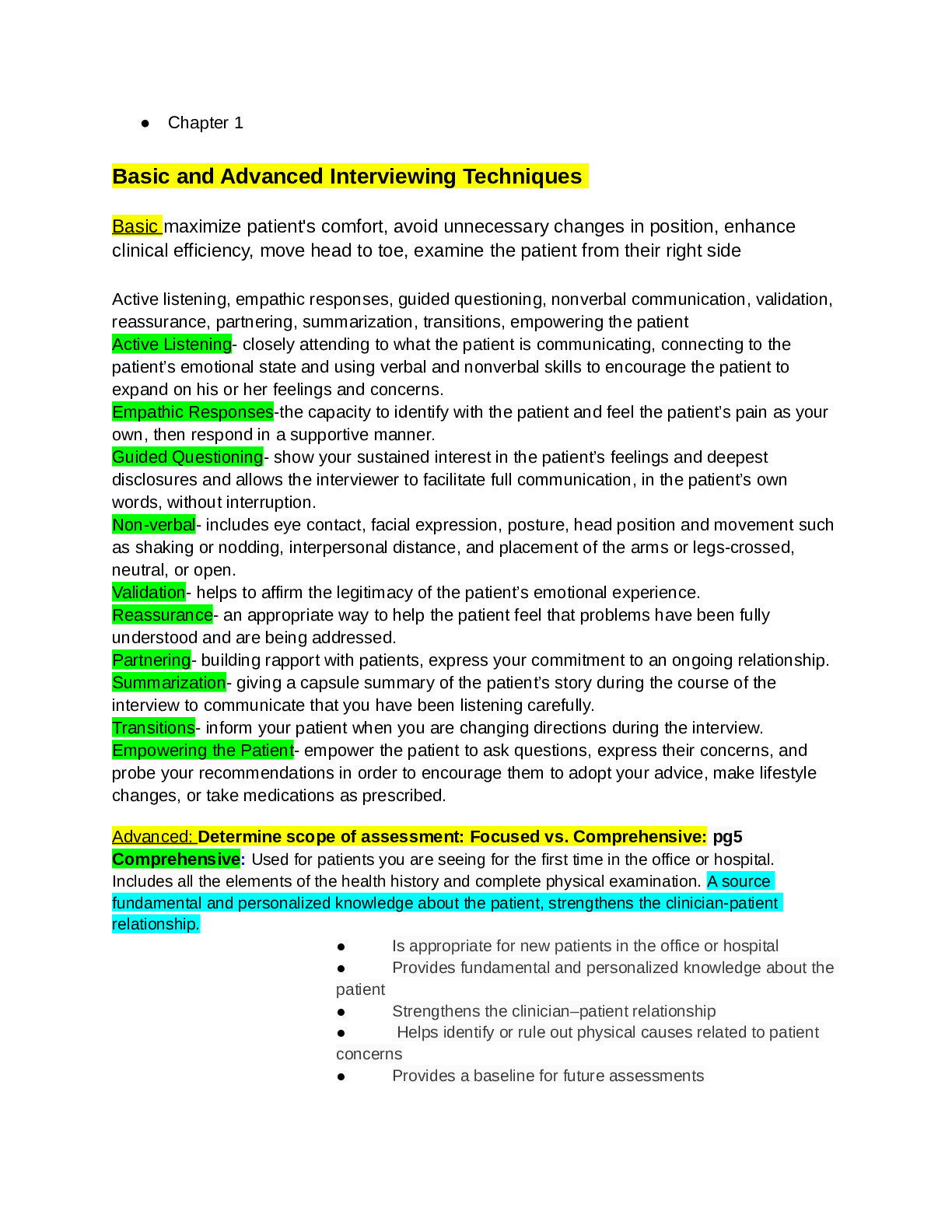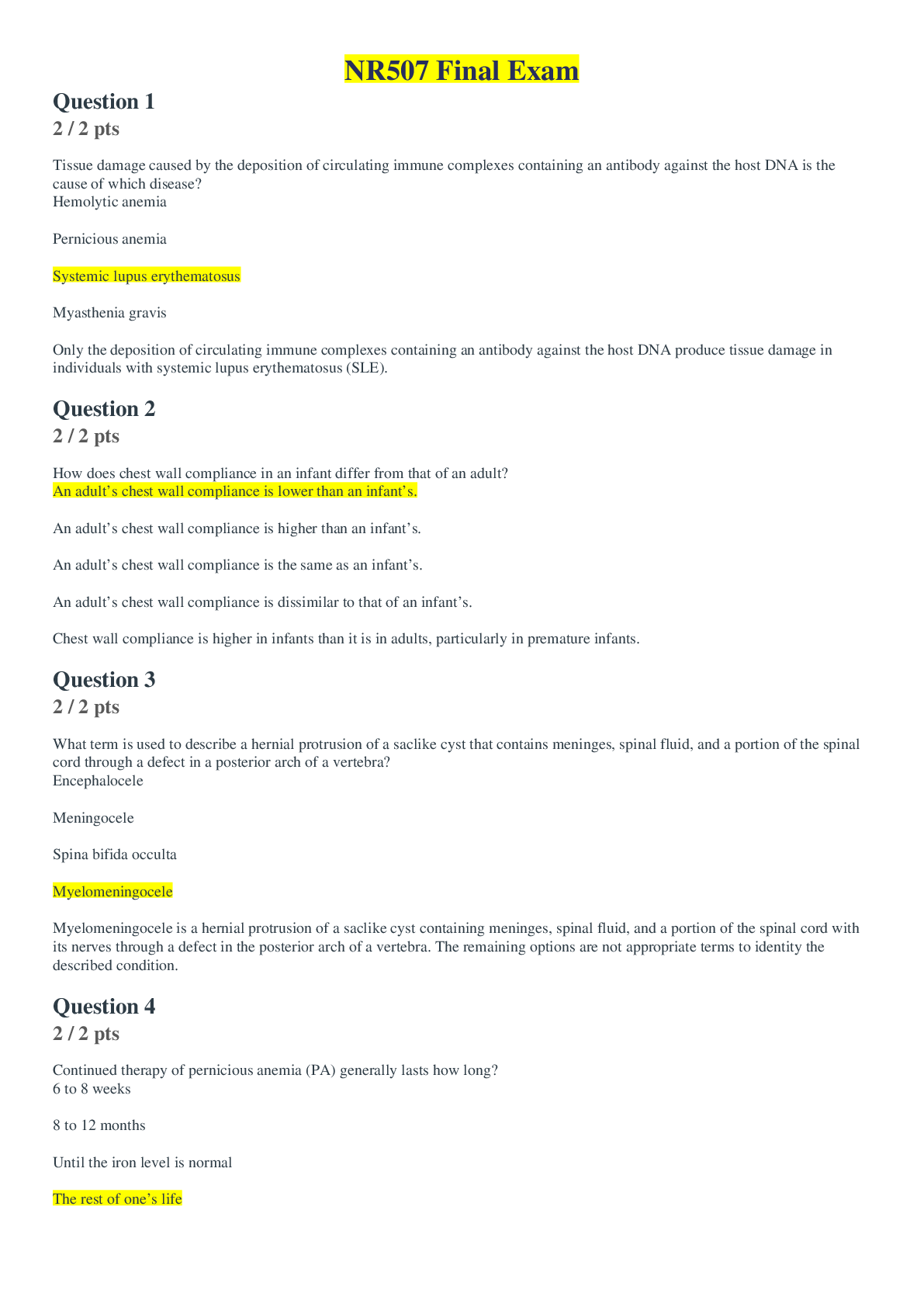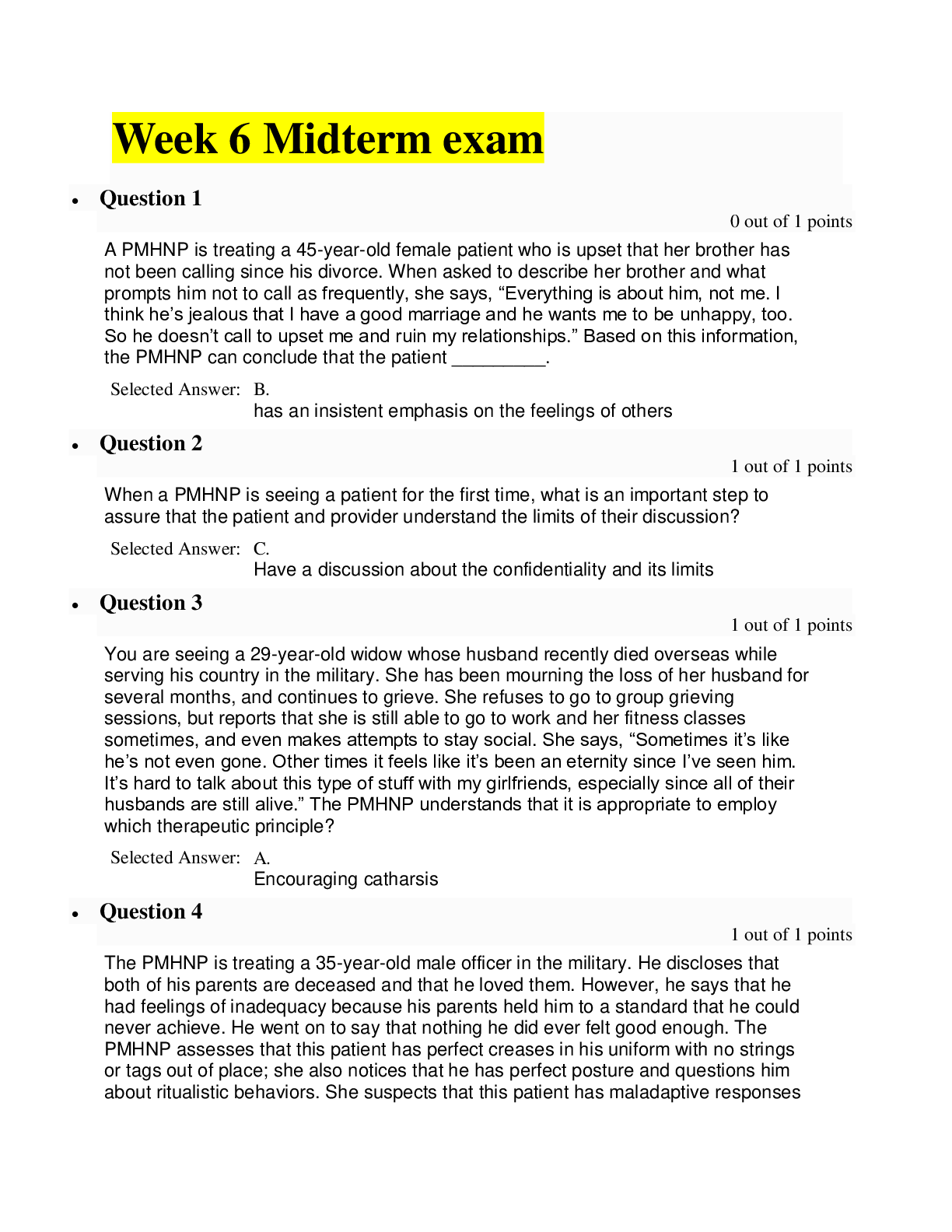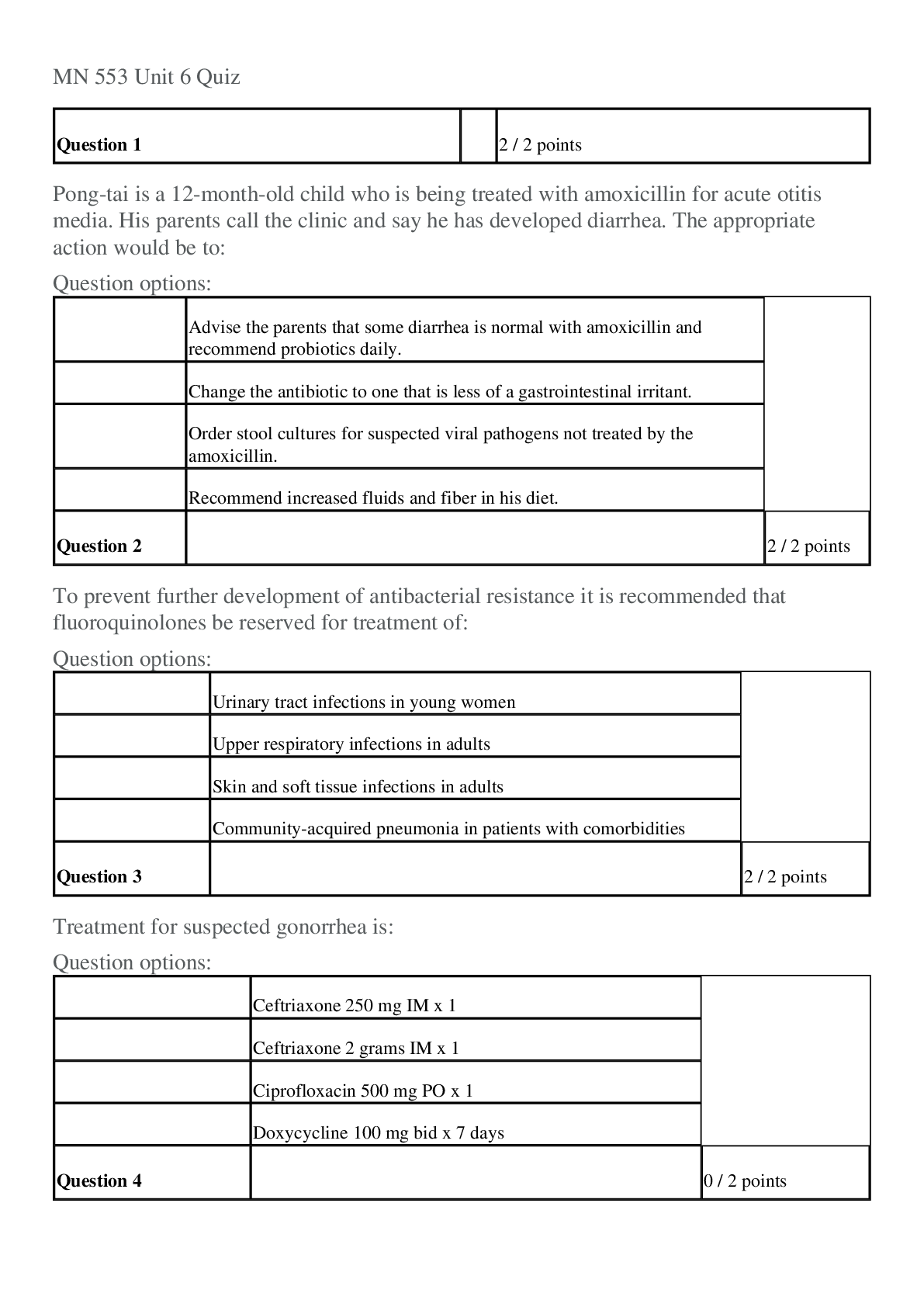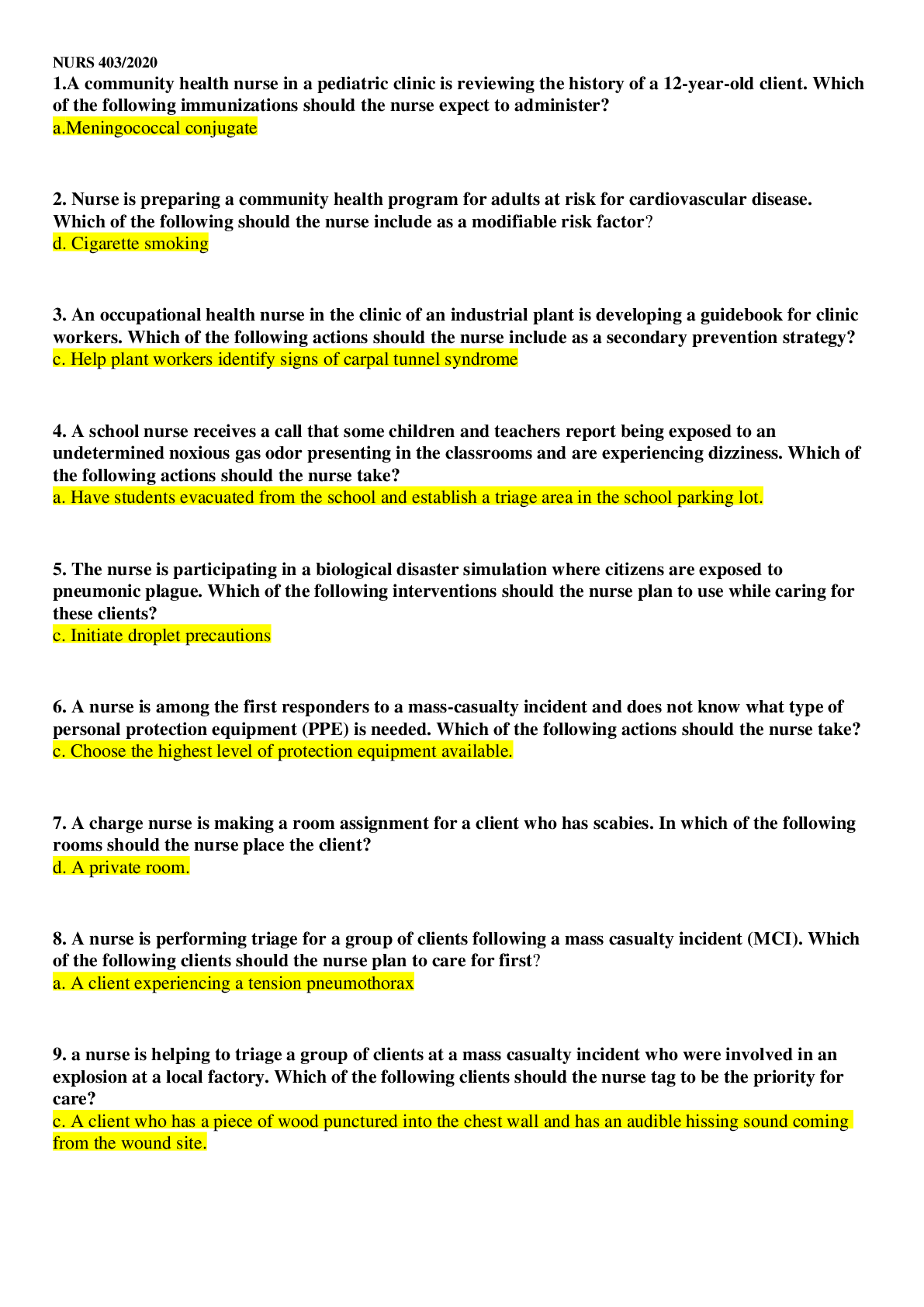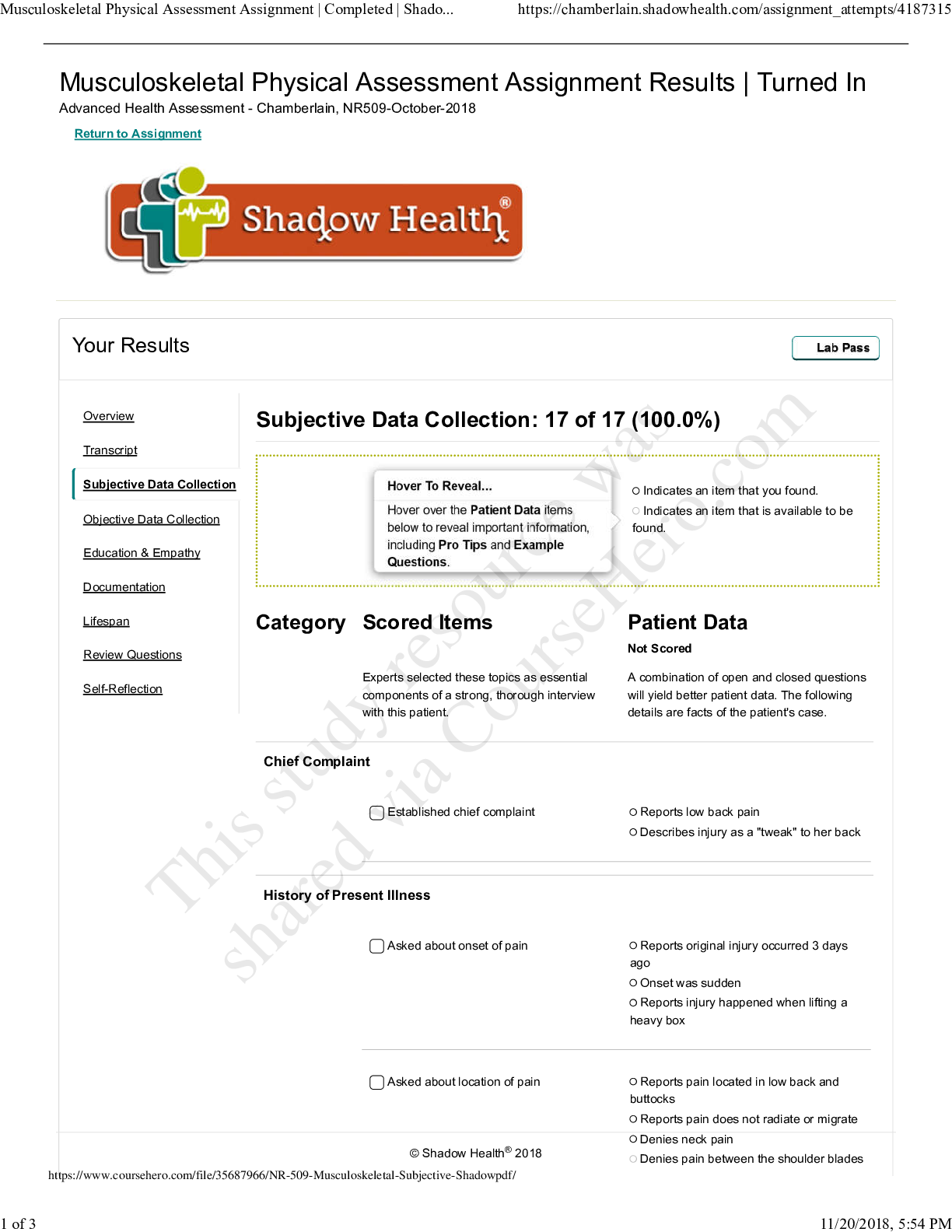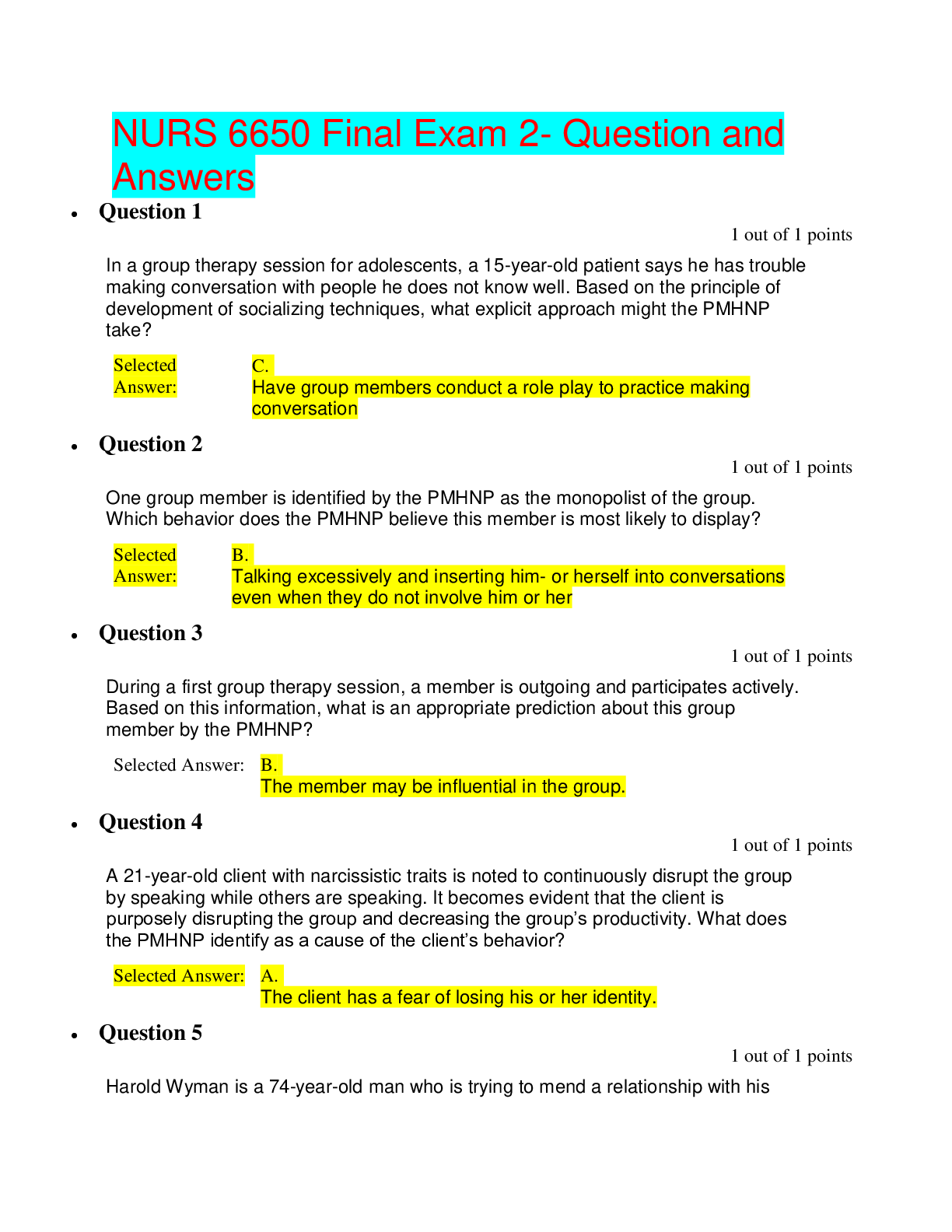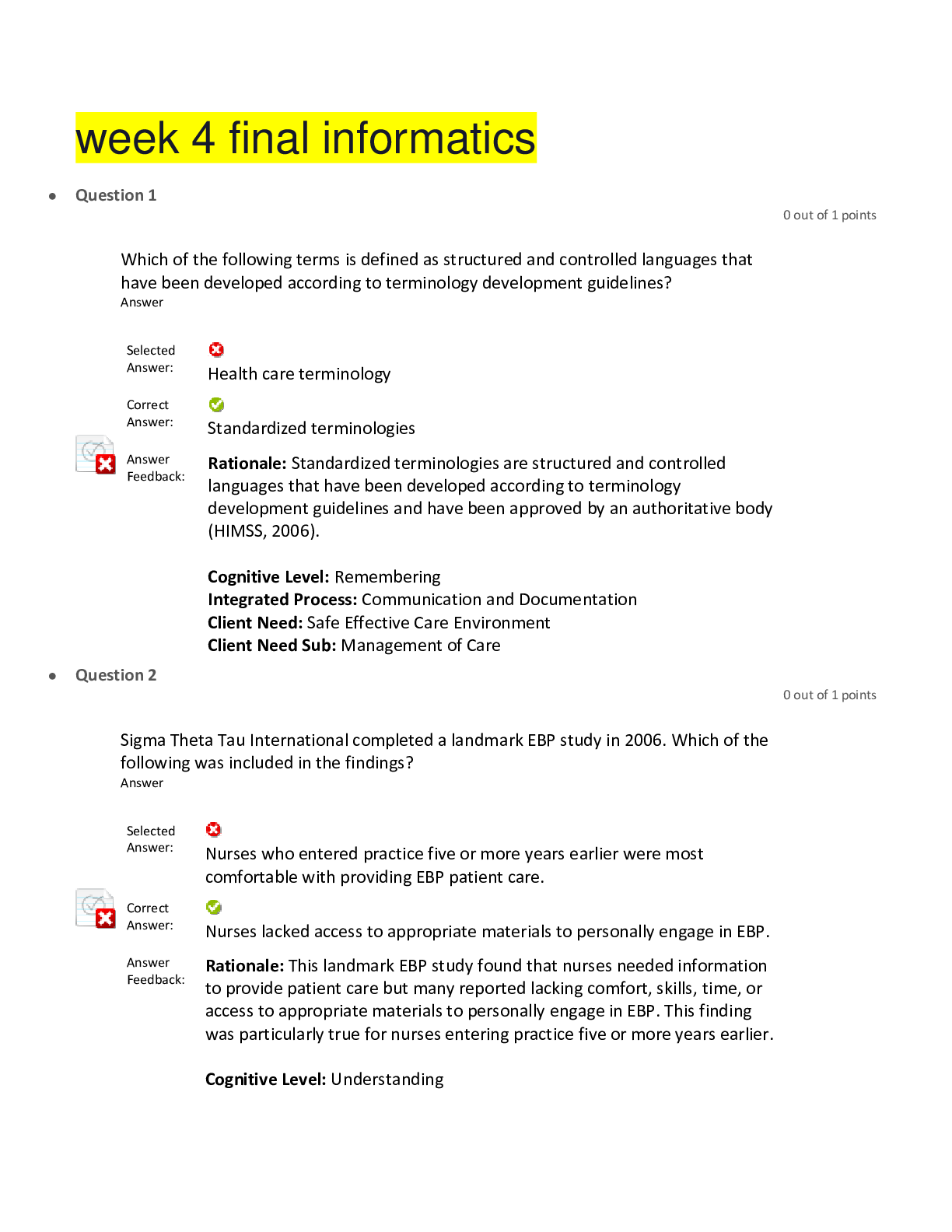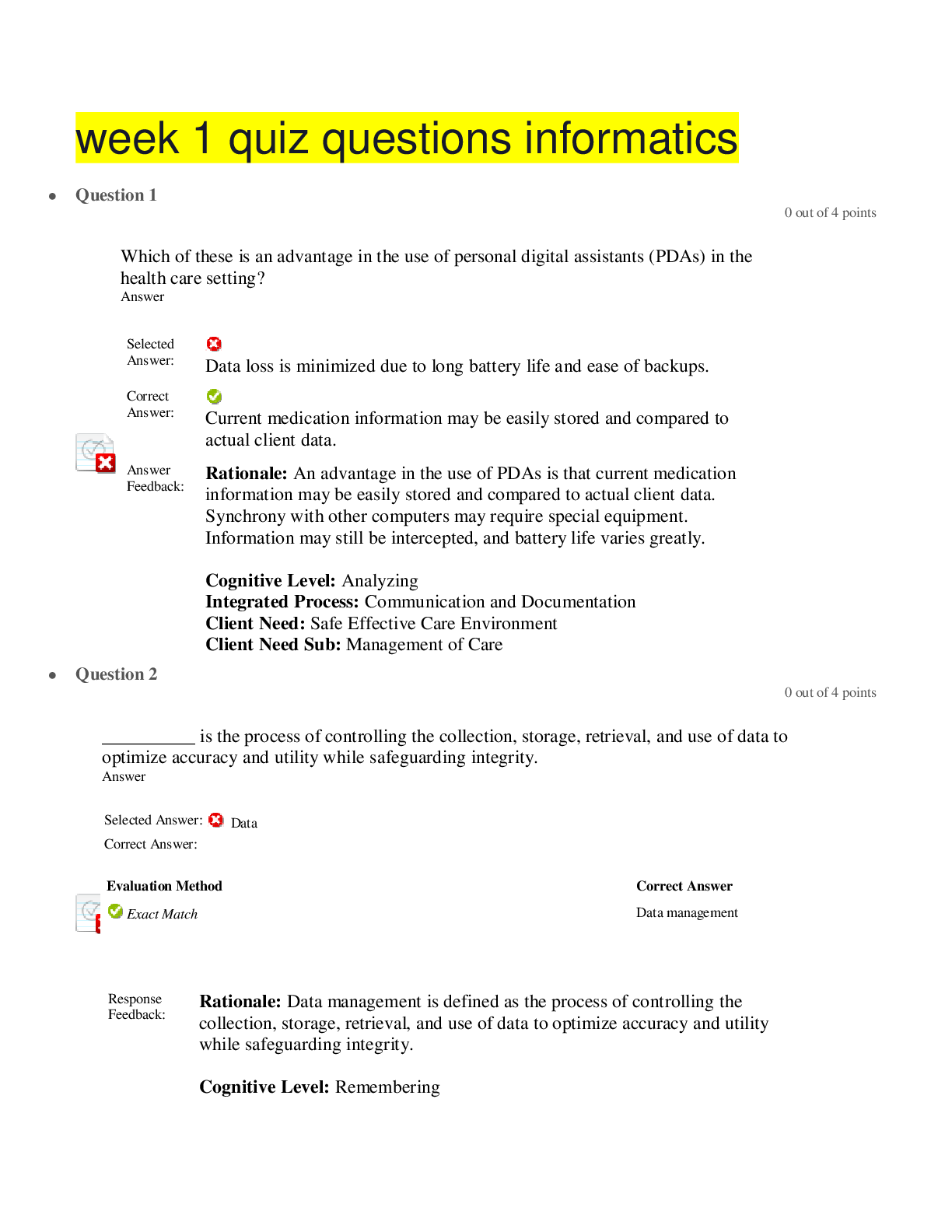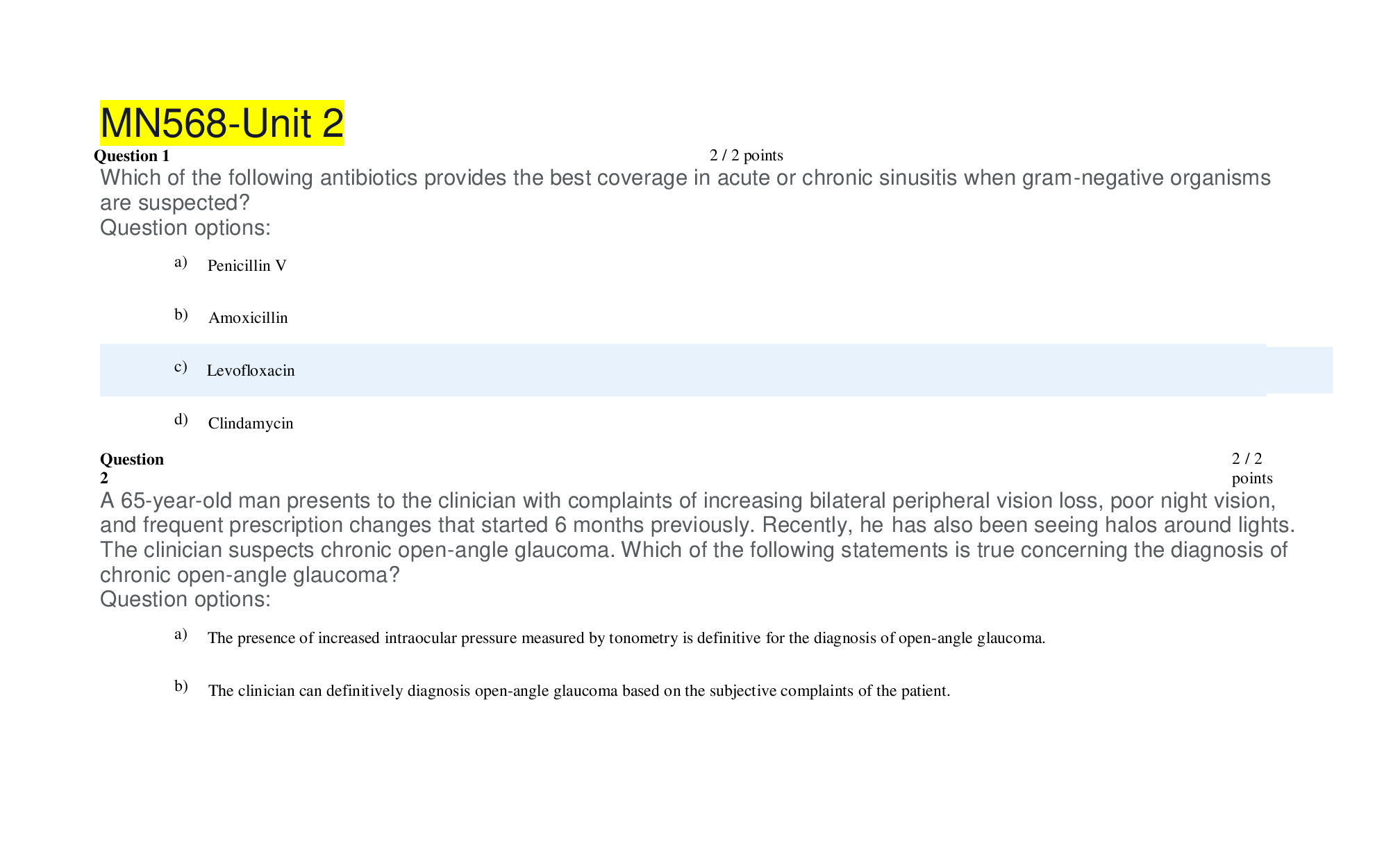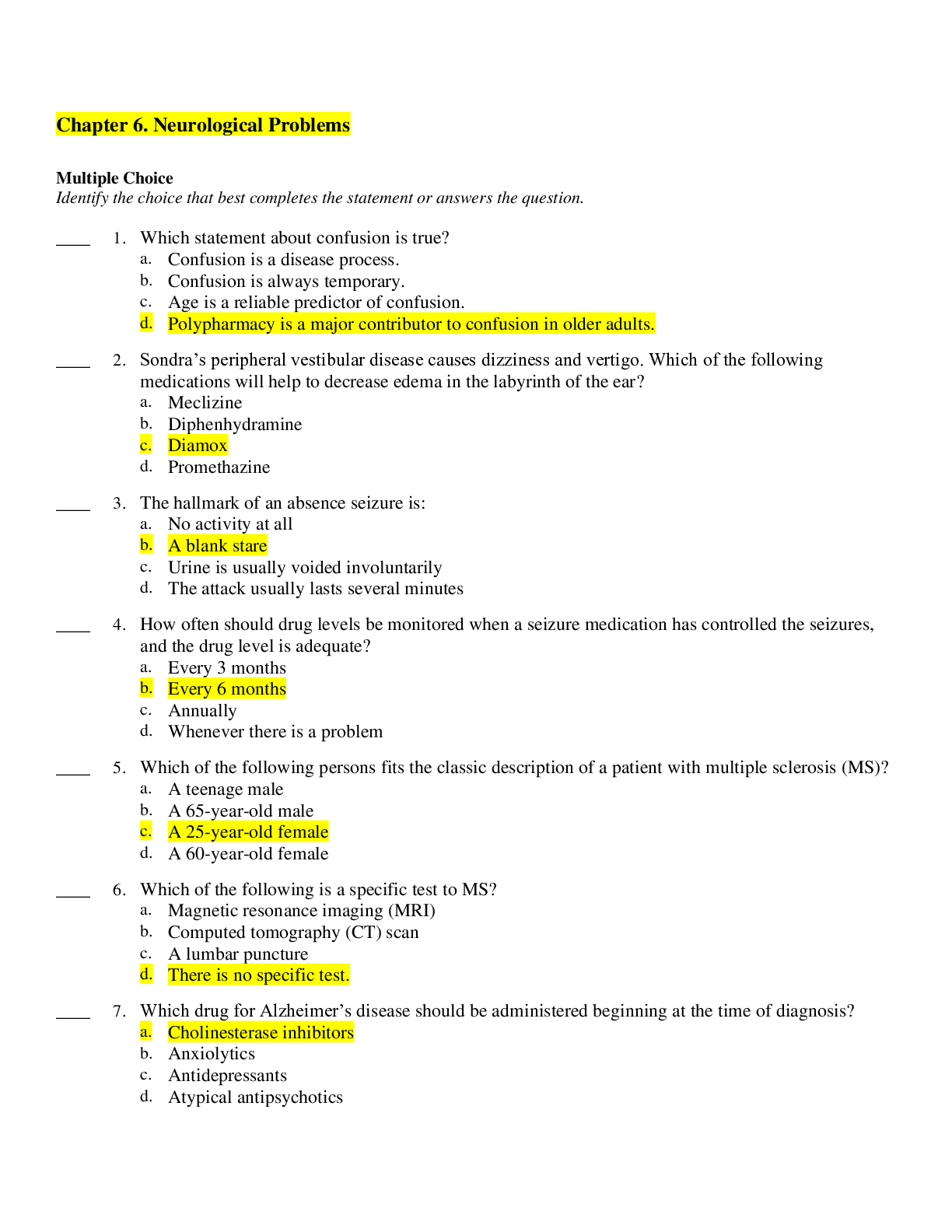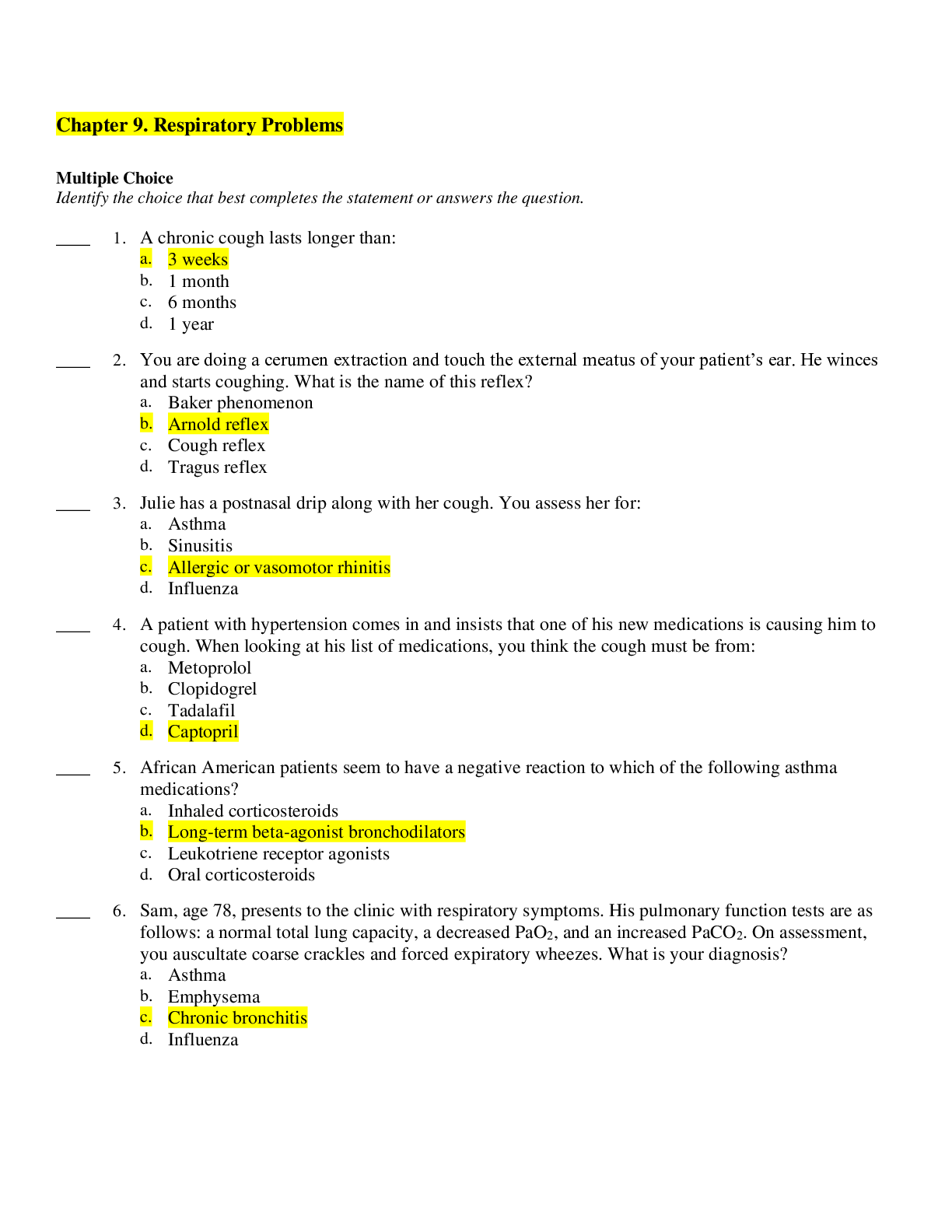*NURSING > EXAM > Keiser University - NURSING NUR3065 Ch07 Skin Problems Question And Answers_100% Verified Answers. (All)
Keiser University - NURSING NUR3065 Ch07 Skin Problems Question And Answers_100% Verified Answers.
Document Content and Description Below
Chapter 7. Skin Problems Multiple Choice Identify the choice that best completes the statement or answers the question. ____ 1. Simon presents with alopecia areata with well-circumscribed patch... es of hair loss on the crown of his head. How do you respond when he asks you the cause? a. “You must be under a lot of stress lately.” b. “It is hereditary. Did your father experience this also?” c. “The cause is unknown, but we suspect it is due to an immunologic mechanism.” d. “We’ll have to do some tests.” ____ 2. Which of the following is “a linear crack extending from the epidermis to the dermis?” a. An ulcer b. A fissure c. Lichenification d. An excoriation ____ 3. A bulla is: a. A vesicle larger than 1 cm in diameter b. An elevated solid mass with a hard texture; the shape and borders can be regular or irregular c. A superficial elevated lesion filled with purulent fluid d. Thinning of the skin (epidermis and dermis) that appears white or translucent ____ 4. An example of ecchymosis is: a. A hematoma b. A keloid c. A bruise d. A patch ____ 5. When looking under the microscope to diagnose an intravaginal infection, you see a cluster of small and oval to round shapes. What do you suspect they are? a. Spores b. Leukocytes c. Pseudohyphae d. Epithelial cells ____ 6. Your patient is in her second trimester of pregnancy and has a yeast infection. Which of the following is a treatment that you usually recommend/order in nonpregnant patients, but is listed as a Pregnancy category D? a. Vagistat vaginal cream b. Monistat combination pack c. Terazol vaginal cream d. Diflucan, 150 mg ____ 7. Tinea unguium is also known as: a. Onychomycosis b. Tinea versicolor c. Tinea manuum d. Tinea corporis ____ 8. Sally, age 25, presents with impetigo that has been diagnosed as infected with Staphylococcus. The clinical presentation is pruritic tender, red vesicles surrounded by erythema with a rash that is ulcerating. Her recent treatment has not been adequate. Which type of impetigo is this? a. Bullous impetigo b. Staphylococcal scalded skin syndrome (SSSS) c. Nonbullous impetigo d. Ecthyma ____ 9. Mark has necrotizing fasciitis of his left lower extremity. Pressure on the skin reveals crepitus due to gas production by which anaerobic bacteria? a. Staphylococcal aureus b. Clostridium perfringens c. S. pyrogenes d. Streptococcus ____ 10. When using the microscope for an intravaginal infection, you see something translucent and colorless. What do you suspect? a. A piece of hair or a thread b. Hyphae c. Leukocytes d. Spores ____ 11. Marci has a wart on her hand. She says she heard something about “silver duct tape therapy.” What do you tell her about his? a. It is an old wives’ tale. b. It is used as a last resort. c. Salicylic acid is more effective. d. It is a simple treatment that should be tried first. ____ 12. Which is the most potent and irritating dose of tretinoin? a. 0.05% liquid formulation b. 0.1% cream c. 1% foam d. 0.02% cream ____ 13. Of the following types of cellulitis, which is a streptococcal infection of the superficial layers of the skin that does not involve the subcutaneous layers? a. Necrotizing fasciitis b. Periorbital cellulitis c. Erysipelas d. “Flesh-eating” cellulitis ____ 14. Mandy presents with a cauliflower-like wart in her anogenital region. You suspect it was sexually transmitted and document this as a: a. Filiform/digitate wart b. Dysplastic cervical lesion c. Condyloma acuminata d. Koilocytosis ____ 15. Jeffrey has atopic dermatitis. You are prescribing a low-dose topical corticosteroid for him. Which would be a good choice? a. Betamethasone dipropionate 0.05% b. Hydrocortisone base 2.5% c. Halcinonide 0.1% d. Desonide 0.05% ____ 16. Harvey has a rubbery, smooth, round mass on his chest that is compressible and has a soft-to-very-firm texture. What do you diagnose this as? a. A lipoma b. A nevi c. A skin tag d. A possible adenoma ____ 17. Which of the following statements is accurate when you are removing a seborrheic keratosis lesion using liquid nitrogen? a. Do not use lidocaine as it may potentiate bleeding. b. Pinch the skin taut together. c. Use gel foam to control bleeding. d. This should be performed by a dermatologist only. ____ 18. The “B” in the ABCDEs of assessing skin cancer represents: a. Biopsy b. Best practice c. Boundary d. Border irregularity ____ 19. The majority of HSV-1 and HSV-2 infections are asymptomatic so that only which elevated antibody titer shows evidence of previous infection? a. IgA b. IgE c. IgG d. IgM ____ 20. Eighty percent of men have noticeable hair loss by what age? a. 35 b. 50 c. 70 d. 85 ____ 21. Prevalence of psoriasis is highest in which group? a. Scandinavians b. African Americans c. Asians d. Native Americans ____ 22. The most common precancerous skin lesion found in Caucasians is: a. A skin tag b. Actinic keratosis c. A melanoma d. A basal cell lesion ____ 23. Ian, age 62, presents with a wide, diffuse area of erythematous skin on his lower left leg that is warm and tender to palpation. There is some edema involved. You suspect: a. Necrotizing fasciitis b. Kaposi’s sarcoma c. Cellulitis d. A diabetic ulcer ____ 24. Josh, aged 22, has tinea versicolor. Which description is the most likely for this condition? a. There are round, hypopigmented macules on his back. b. Josh has red papules on his face. c. There are crusted plaques in Josh’s groin area. d. There are white streaks on his neck. ____ 25. Tori is on systemic antifungals for a bad tinea infection. You are aware that the antifungals may cause: a. Renal failure b. Skin discoloration c. Breathing difficulties d. Hepatotoxicity ____ 26. Which scalp problem can be caused by a fever and certain drugs? a. Telogen effluvium (TE) b. Trichotillomania c. Psoriasis d. Alopecia areata ____ 27. Why do people of African descent have a lower incidence of non-melanoma skin cancer? a. They have an increased number of melanocytes. b. Their darker skin protects from ultraviolet radiation. c. Their skin is thicker. d. Their immune system is stronger. ____ 28. Which statement is true regarding chloasma, the ‘mask of pregnancy’? a. It is caused by a decrease in the melanocyte-stimulating hormone during pregnancy. b. This condition only occurs on the face. c. Exposure to sunlight will even out the discoloration. d. It is caused by increased levels of estrogen and progesterone. ____ 29. When instructing your elderly client about treating her xerosis, what do you tell her? a. A daily hot bath may help the associated pruritus. b. Rub the skin briskly to make sure it is completely dry after bathing. c. Only take short tepid showers. d. Use a gel that is alcohol-based after bathing to soften the skin. ____ 30. Which medication used for scabies is safe for children 2 months and older? a. Permethrin cream b. Lindane c. Crotamiton lotion and cream d. Ivermectin ____ 31. Which of the following is an infraorbital fold skin manifestation in a patient with atopic dermatitis? a. Keratosis pilaris b. Dennie’s sign c. Keratoconus d. Pityriasis alba ____ 32. Which of the following statements about performing cryosurgery for actinic keratosis is true? a. It is better to slightly overfreeze the area, so you only have to do it once. b. Using liquid nitrogen, freeze each lesion for at least 30 seconds. c. Every lesion should be biopsied after using liquid nitrogen. d. The ‘freeze balls’ should be approximately one-and-a-half times as wide as they are deep. ____ 33. An example of a primary skin lesion is a/an: a. Bulla b. Scale c. Excoriation d. Fissure ____ 34. Which statement regarding necrotizing fasciitis is true? a. The hallmark of this infection is its slow and steady progression. b. Once the border of the infection is “established,” it does not spread. c. Loss of life or limb is a potential complication. d. The lesion is most dangerous, because it is painless. ____ 35. When staging a malignant melanoma using Clark’s levels, which level extends into the papillary dermis? a. Level I b. Level II c. Level III d. Level IV Chapter 7. Skin Problems Answer Section [Show More]
Last updated: 1 year ago
Preview 1 out of 6 pages
Instant download
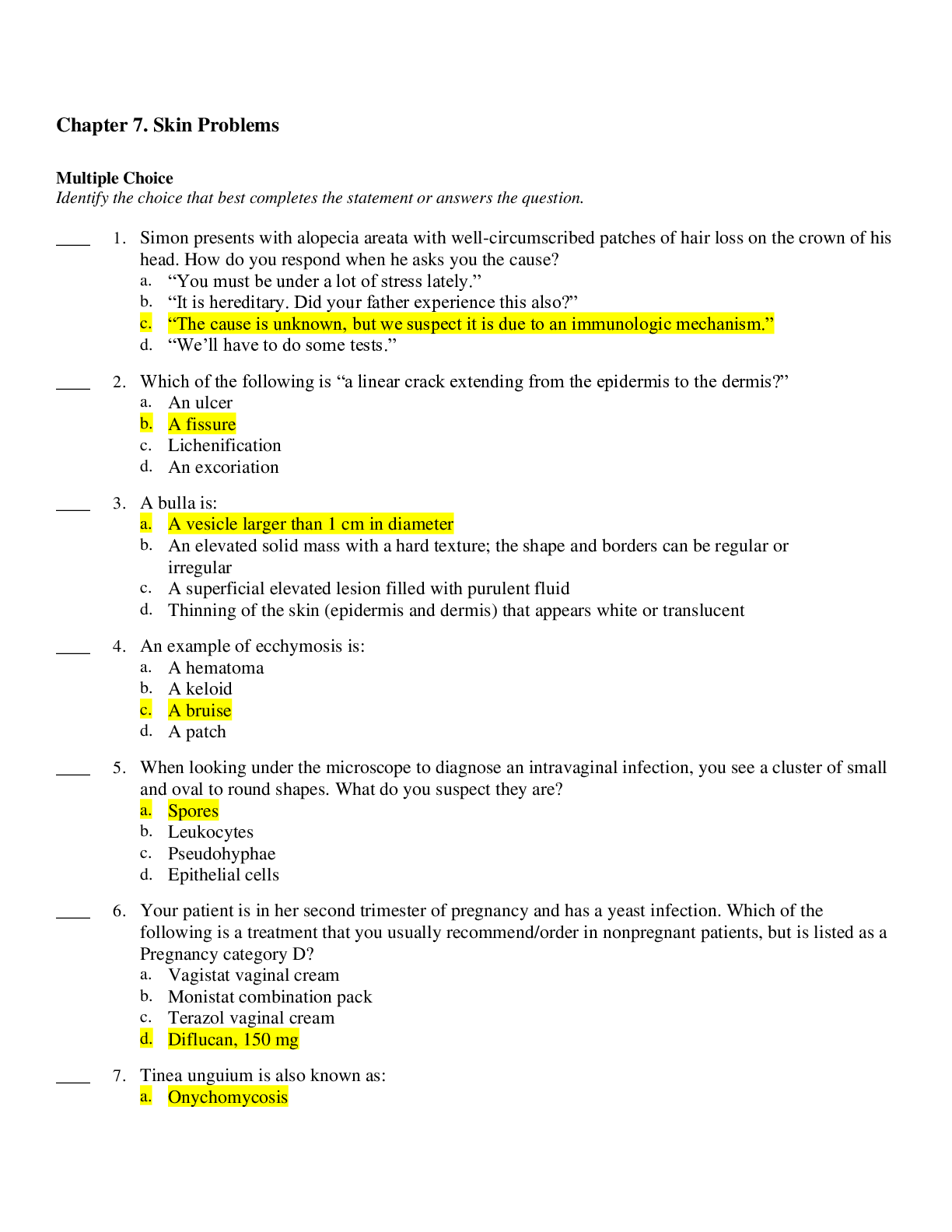
Buy this document to get the full access instantly
Instant Download Access after purchase
Add to cartInstant download
Reviews( 0 )
Document information
Connected school, study & course
About the document
Uploaded On
Aug 05, 2020
Number of pages
6
Written in
Additional information
This document has been written for:
Uploaded
Aug 05, 2020
Downloads
0
Views
68


